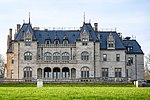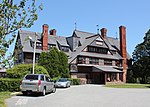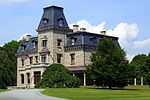Fairholme (Newport, Rhode Island)
Gilded Age mansionsHouses in Newport, Rhode IslandResidential buildings completed in 1875Tudor Revival architecture in Rhode Island

Fairholme is a Tudor Revival historic mansion in Newport, Rhode Island designed by Frank Furness and built by Furness & Hewitt in 1874–1875 for Fairman Rogers.
Excerpt from the Wikipedia article Fairholme (Newport, Rhode Island) (License: CC BY-SA 3.0, Authors, Images).Fairholme (Newport, Rhode Island)
Ruggles Avenue, Newport
Geographical coordinates (GPS) Address Nearby Places Show on map
Geographical coordinates (GPS)
| Latitude | Longitude |
|---|---|
| N 41.46799 ° | E -71.299248 ° |
Address
Ruggles Avenue
Ruggles Avenue
02840 Newport
Rhode Island, United States
Open on Google Maps










